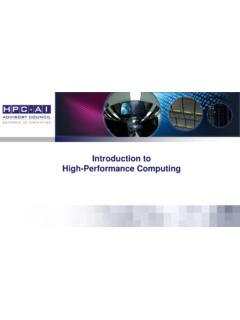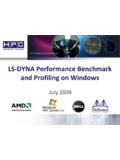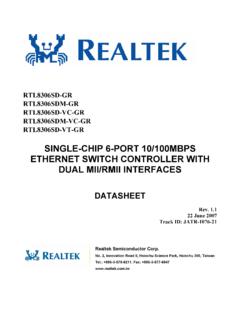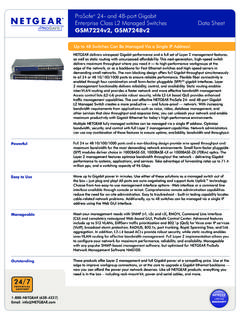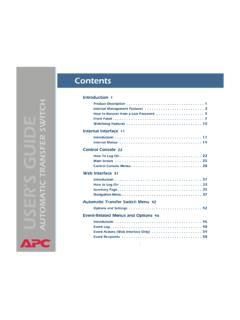Transcription of Introduction to High-Speed InfiniBand Interconnect
1 Introduction to High-Speed InfiniBand Interconnect2 Industry standard defined by the InfiniBand Trade Association Originated in 1999 InfiniBand specification defines an input/output architecture used to Interconnect servers, communications infrastructure equipment, storage and embedded systems InfiniBand is a pervasive, low-latency, high-bandwidth Interconnect which requires low processing overhead and is ideal to carry multiple traffic types (clustering, communications, storage, management) over a single connection. As a mature and field-proven technology, InfiniBand is used in thousands of data centers, high-performance compute clusters and embedded applications that scale from small scale to large scaleWhat is InfiniBand ?
2 Source: InfiniBand Trade Association (IBTA) InfiniBand Architecture Industry standard defined by the InfiniBand Trade Association Defines System Area Network architecture Comprehensive specification: from physical to applications Architecture supports Host Channel Adapters (HCA) Target Channel Adapters (TCA) Switches Routers Facilitated HW design for Low latency / high bandwidth Transport offloadProcessorNodeInfiniBandSubnetGate wayHCAP rocessorNodeProcessorNodeHCAHCATCAS torageSubsystemConsolesTCARAIDE thernetGatewayFibreChannelHCAS ubnet Manager SwitchSwitchSwitchSwitch4 InfiniBand Highlights serial High Bandwidth Links SDR: 10Gb/s DDR: 20Gb/s QDR: 40Gb/s FDR: 56Gb/s EDR: 100Gb/s HDR.
3 200Gb/s Ultra low latency Under 1 us application to application Reliable, lossless, self-managing fabric Link level flow control Congestion control to prevent HOL blocking Full CPU Offload Hardware Based Reliable Transport Protocol Kernel Bypass (User level applications get direct access to hardware) Memory exposed to remote node access RDMA-read and RDMA-write Atomic operations Quality Of Service Independent I/O channels at the adapter level Virtual Lanes at the link level Cluster Scalability/flexibility Up to 48K nodes in subnet.
4 Up to 2^128 in network Parallel routes between end nodes Multiple cluster topologies possible Simplified Cluster Management Centralized route manager In-band diagnostics and upgrades5 InfiniBand Network StackUser codeKernel codeHardwareInfiniBandnodeInfiniBandSwit chLegacynodeApplicationNetworkLayerLinkL ayerPhysicalLayerTransportLayerNetworkLa yerLinkLayerPhysicalLayerPacket relayPHYP acket relayPHYPHYLinkPHYLinkRouterBufferBuffer BufferTransportLayerApplication6 InfiniBand Components Overview Host Channel Adapter (HCA) Device that terminates an IB link and executes transport-level functions and support the verbs interface Switch A device that routes packets from one link to another of the same IB Subnet Router A device that transports packets between IBA subnets Bridge InfiniBand to Ethernet7 Physical Layer Link Rate InfiniBand uses serial stream of bits for data transfer Link width 1x One differential pair per Tx/Rx 4x Four differential pairs per Tx/Rx 12x -Twelve differential pairs per Txand per Rx Link Speed Single Data Rate (SDR)
5 Per lane (10Gb/s for 4x) Double Data Rate (DDR) -5Gb/s per lane (20Gb/s for 4x) Quad Data Rate (QDR) -10Gb/s per lane (40Gb/s for 4x) Fourteen Data Rate (FDR) -14Gb/s per lane (56Gb/s for 4x) Enhanced Data rate (EDR) -25Gb/s per lane (100Gb/s for 4x) Link rate Multiplication of the link width and link speed Most common shipping today is 4x ports8 Physical Layer Cables Media types PCB: several inches Passive copper: 20m SDR, 10m DDR, 7m QDR, 3m FDR, 3m EDR, 3m HDR Fiber: 300m SDR, 150m DDR, 100/300m QDR Link encoding SDR, DDR, QDR: 8 to 10 bit encoding FDR, EDR, HDR.
6 64 to 66 bit encoding Industry standard components Copper cables / Connectors Optical cables Backplane connectors4X QSFP Copper4x QSFP Fiber FR4 PCB9 ArbitrationDe-muxMuxLink ControlPacketsCreditsReturnedLink ControlReceiveBuffersPackets TransmittedLink Layer Flow Control Credit-based link-level flow control Link Flow control assures no packet loss within fabric even in the presence of congestion Link Receivers grant packet receive buffer space credits per Virtual Lane Flow control credits are issued in 64 byte units Separate flow control per Virtual Lanes provides.
7 Alleviation of head-of-line blocking Virtual Fabrics Congestion and latency on one VL does not impact traffic with guaranteed QOS on another VL even though they share the same physical link10 Remote QPLocal QPTransport Layer Using Queue Pairs QPs are in pairs (Send/Receive) Work Queue is the consumer/producer interface to the fabric The Consumer/producer initiates a Work Queue Element (WQE) The Channel Adapter executes the work request The Channel Adapter notifies on completion or errors by writing a Completion Queue Element (CQE) to a Completion Queue (CQ)
8 TransmitReceiveReceiveTransmitWQE11 Transport Layer Types Transfer Operations SEND Read message from HCA local system memory Transfers data to Responder HCA Receive Queue logic Does not specify where the data will be written in remote memory Immediate Data option available RDMA Read Responder HCA reads its local memory and returns it to the Requesting HCA Requires remote memory access rights, memory start address, message length RDMA Write Requester HCA sends data to be written into the Responder HCA s system memory Requires remote memory access rights, memory start address.
9 Message length12 Management Model IBA management defines a common management infrastructure Subnet Management Provides methods for a subnet manager to discover and configure IBA devices Manage the fabric General management services Subnet administration -provides nodes with information gathered by the SM Provides a registrar for nodes to register general services they provide Communication establishment and connection management between end nodes Performance management Monitors and reports well-defined performance counters And ModelQP1 (virtualized per port)Uses any VL except 15 MADs called GMPs -LID-RoutedSubject to Flow Control Baseboard Management AgentCommunication Mgmt (Mgr/Agent)Performance Management AgentDevice Management AgentVendor-Specific AgentApplication-Specific AgentSNMP Tunneling AgentSubnet Administration (an Agent)General Service InterfaceSubnet Manager (SM) AgentSubnet ManagerSubnet Management InterfaceQP0 (virtualized per port)
10 Always uses VL15 MADs called SMPs LID or Direct-RoutedNo Flow Control14 Subnet Management CPUHCAS ystemMemoryHCAIB SwitchIB SwitchHCAIB SwitchTCAHCAS ubnet ManagerEach Subnet must have a Subnet Manager (SM)SMASMASMASMASMASMASMASMAE very entity (CA, SW, Router) must support a Subnet Management Agent (SMA)Subnet ManagerHCAIB SwitchStandbySMStandbySMStandby SMTopology DiscoveryFabric MaintenanceLID RouteDirected Route VectorLID RouteInitialization usesDirected Route packets:Multipathing: LMC SupportsMultiple LIDS15 Cluster Topologies Topologies that are mainly in use for large clusters Fat-Tree 3D Torus Mesh Dragonfly Fat-tree (also known as CBB) Flat network, can be set as oversubscribed network or not In other words, blocking or non blocking Typically the lowest latency network 3D Torus An oversubscribed network, easier to scale Fit more applications with locality Dragonfly A generic concept of connecting groups or virtual routers together In a full-graph (all to all)
